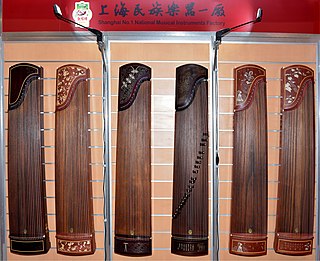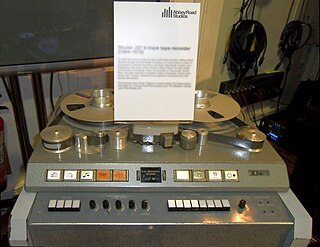Related Research Articles

Musical composition can refer to an original piece or work of music, either vocal or instrumental, the structure of a musical piece or to the process of creating or writing a new piece of music. People who create new compositions are called composers. Composers of primarily songs are usually called songwriters; with songs, the person who writes lyrics for a song is the lyricist. In many cultures, including Western classical music, the act of composing typically includes the creation of music notation, such as a sheet music "score", which is then performed by the composer or by other musicians. In popular music and traditional music, songwriting may involve the creation of a basic outline of the song, called the lead sheet, which sets out the melody, lyrics and chord progression. In classical music, orchestration is typically done by the composer, but in musical theatre and in pop music, songwriters may hire an arranger to do the orchestration. In some cases, a pop or traditional songwriter may not use written notation at all and instead compose the song in their mind and then play, sing or record it from memory. In jazz and popular music, notable sound recordings by influential performers are given the weight that written or printed scores play in classical music.

A record producer or music producer is a music creating project's overall supervisor whose responsibilities can involve a range of creative and technical leadership roles. Typically the job involves hands-on oversight of recording sessions; ensuring artists deliver acceptable and quality performances, supervising the technical engineering of the recording, and coordinating the production team and process. The producer's involvement in a musical project can vary in depth and scope. Sometimes in popular genres the producer may create the recording's entire sound and structure. However, in classical music recording, for example, the producer serves as more of a liaison between the conductor and the engineering team. The role is often likened to that of a film director though there are important differences. It is distinct from the role of an executive producer, who is mostly involved in the recording project on an administrative level, and from the audio engineer who operates the recording technology.

In C is a musical piece composed by Terry Riley in 1964. It consists of series of 53 short melodic fragments that can be repeated at the discretion of the musicians. It is often cited as the first minimalist composition to make a significant impact on the public consciousness and inspire a new movement. The number of performers is unspecified. Riley suggests "a group of about 35 is desired if possible but smaller or larger groups will work".

Audio mixing is the process by which multiple sounds are combined into one or more audio channels. In the process, a source's volume level, frequency content, dynamics, and panoramic position are manipulated or enhanced. This practical, aesthetic, or otherwise creative treatment is done in order to produce a finished version that is appealing to listeners.

Multitrack recording (MTR), also known as multitracking, is a method of sound recording developed in 1955 that allows for the separate recording of multiple sound sources or of sound sources recorded at different times to create a cohesive whole. Multitracking became possible in the mid-1950s when the idea of simultaneously recording different audio channels to separate discrete tracks on the same reel-to-reel tape was developed. A track was simply a different channel recorded to its own discrete area on the tape whereby their relative sequence of recorded events would be preserved, and playback would be simultaneous or synchronized.

Reel-to-reel audio tape recording, also called open-reel recording, is magnetic tape audio recording in which the recording tape is spooled between reels. To prepare for use, the supply reel containing the tape is placed on a spindle or hub. The end of the tape is manually pulled from the reel, threaded through mechanical guides and over a tape head assembly, and attached by friction to the hub of the second, initially empty takeup reel. Reel-to-reel systems use tape that is 1⁄4, 1⁄2, 1, or 2 inches wide, which normally moves at 3+3⁄4, 7+1⁄2, 15 or 30 inches per second. Domestic consumer machines almost always used 1⁄4 inch (6.35 mm) or narrower tape and many offered slower speeds such as 1+7⁄8 inches per second (4.762 cm/s). All standard tape speeds are derived as a binary submultiple of 30 inches per second.
Oskar Wilhelm Fischinger was a German-American abstract animator, filmmaker, and painter, notable for creating abstract musical animation many decades before the appearance of computer graphics and music videos. He created special effects for Fritz Lang's 1929 Woman in the Moon, one of the first sci-fi rocket films, and influenced Disney's Fantasia. He made over 50 short films and painted around 800 canvases, many of which are in museums, galleries, and collections worldwide. Among his film works is Motion Painting No. 1 (1947), which is now listed on the National Film Registry of the U.S. Library of Congress.

Beatboxing is a form of vocal percussion primarily involving the art of mimicking drum machines, using one's mouth, lips, tongue, and voice. It may also involve vocal imitation of turntablism, and other musical instruments. Beatboxing today is connected with hip-hop culture, often referred to as "the fifth element" of hip-hop, although it is not limited to hip-hop music. The term "beatboxing" is sometimes used to refer to vocal percussion in general.

The lead vocalist in popular music is typically the member of a group or band whose voice is the most prominent melody in a performance where multiple voices may be heard. The lead singer sets their voice against the accompaniment parts of the ensemble as the dominant sound. In vocal group performances, notably in soul and gospel music, and early rock and roll, the lead singer takes the main vocal melody, with a chorus or harmony vocals provided by other band members as backing vocalists. Lead vocalists typically incorporate some movement or gestures into their performance, and some may participate in dance routines during the show, particularly in pop music. Some lead vocalists also play an instrument during the show, either in an accompaniment role, or playing a lead instrument/instrumental solo role when they are not singing.
A take is a single continuous recorded performance. The term is used in film and music to denote and track the stages of production.

The zheng or guzheng, is a Chinese plucked zither. The modern guzheng commonly has 21, 25, or 26 strings, is 64 inches long, and is tuned in a major pentatonic scale. It has a large, resonant soundboard made from Paulownia wood. Other components are often made from other woods for structural or decorative reasons. Guzheng players often wear a fingerpick made from materials such as plastic, resin, tortoiseshell, or ivory on one or both hands.
"Gypsy Eyes" or "Gipsy Eyes" is a song written by Jimi Hendrix and performed by the Jimi Hendrix Experience for the 1968 album Electric Ladyland. Subsequently, it was released as the B-side of the "Crosstown Traffic" single, which reached number 52 on the US Billboard Hot 100 and number 37 on the UK Official Singles Chart.
Overdubbing is a technique used in audio recording in which audio tracks that have been pre-recorded are then played back and monitored, while simultaneously recording new, doubled, or augmented tracks onto one or more available tracks of a digital audio workstation (DAW) or tape recorder. The overdub process can be repeated multiple times. This technique is often used with singers, as well as with instruments, or ensembles/orchestras. Overdubbing is typically done for the purpose of adding richness and complexity to the original recording. For example, if there are only one or two artists involved in the recording process, overdubbing can give the effect of sounding like many performers.

A one-man band is a musician who plays a number of instruments simultaneously using their hands, feet, limbs, and various mechanical or electronic contraptions. One-man bands also often sing while they perform.
Double tracking or doubling is an audio recording technique in which a performer sings or plays along with their own prerecorded performance, usually to produce a stronger or bigger sound than can be obtained with a single voice or instrument. It is a form of overdubbing; the distinction comes from the doubling of a part, as opposed to recording a different part to go with the first. The effect can be further enhanced by panning one of the performances hard left and the other hard right in the stereo field.
The history of sound recording - which has progressed in waves, driven by the invention and commercial introduction of new technologies — can be roughly divided into four main periods:

In filmmaking, television production and video production, the single-camera setup or single-camera mode of production is a method in which all of the various shots and camera angles are taken using the same camera.
Sidney Nicklas Laverents was an American amateur filmmaker, who started making films at home when he was 50. Recognized as one of the industry's most successful hobbyists, his 1970 film Multiple SIDosis is one of the few amateur films to have been selected for inclusion in the National Film Registry.
Ross Lipman is an American restorationist, independent filmmaker, and essayist. He is best known for his 2015 documentary Notfilm, as well as his work with the Bruce Conner Family Trust and as Senior Film Restorationist at the UCLA Film & Television Archive.

In music production, the recording studio is often treated as a musical instrument when it plays a significant role in the composition of music. Sometimes called "playing the studio", the approach is typically embodied by artists or producers who favor the creative use of studio technology in record production, as opposed to simply documenting live performances in studio. Techniques include the incorporation of non-musical sounds, overdubbing, tape edits, sound synthesis, audio signal processing, and combining segmented performances (takes) into a unified whole.